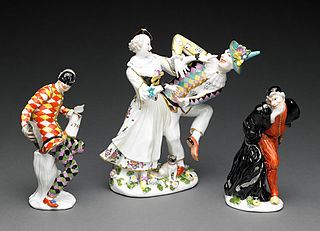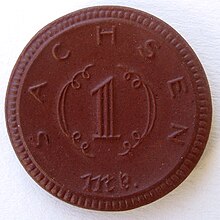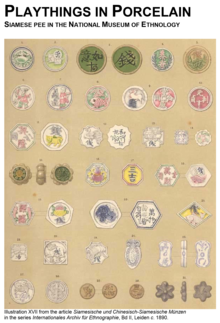
Numismatics is the study or collection of currency, including coins, tokens, paper money, medals and related objects.

Meissen, is a town of approximately 30,000 about 25 km (16 mi) northwest of Dresden on both banks of the Elbe river in the Free State of Saxony, in eastern Germany. Meissen is the home of Meissen porcelain, the Albrechtsburg castle, the Gothic Meissen Cathedral and the Meissen Frauenkirche. The Große Kreisstadt is the capital of the Meissen district.

Exonumia are numismatic items other than coins and paper money. This includes "Good For" tokens, badges, counterstamped coins, elongated coins, encased coins, souvenir medallions, tags, wooden nickels and other similar items. It is an aspect of numismatics and many coin collectors are also exonumists.

Notgeld is money issued by an institution in a time of economic or political crisis. The issuing institution is usually one without official sanction from the central government. This usually occurs when not enough state-produced money is available from the central bank. In particular, notgeld generally refers to money produced in Germany and Austria during World War I and the Interwar period. Issuing institutions could be a town's savings banks, municipalities and private or state-owned firms. Nearly all issues contained an expiry date, after which time they were invalid. Issues without dates ordinarily had an expiry announced in a newspaper or at the place of issuance.

Groschen is the name for various coins, especially a silver coin used in parts of Europe such as France, some of the Italian states, England, various states of the Holy Roman Empire, among others. The word is borrowed from the late Latin description of a tornose, a grossus denarius Turnosus, in English the "thick denarius of Tours". Groschen was frequently abbreviated in old documents to gl, in which the second character was not an L, but an abbreviation symbol; later it was written as Gr or g.

Meissen porcelain or Meissen china was the first European hard-paste porcelain. Early experiments were done in 1708 by Ehrenfried Walther von Tschirnhaus. After his death that October, Johann Friedrich Böttger continued von Tschirnhaus's work and brought this type of porcelain to the market, financed by Augustus the Strong, King of Poland and Elector of Saxony. The production of porcelain in the royal factory at Meissen, near Dresden, started in 1710 and attracted artists and artisans to establish, arguably, the most famous porcelain manufacturer known throughout the world. Its signature logo, the crossed swords, was introduced in 1720 to protect its production; the mark of the swords is reportedly one of the oldest trademarks in existence.

The Nymphenburg Porcelain Manufactory is located at the Nördliches Schloßrondell in one of the Cavalier Houses in front of the Nymphenburg Palace in Munich, Germany, and since its establishment in 1747 has produced porcelain of high quality. It is one of the last porcelain producers in the world where every single part is made entirely by hand.

The Frankenthal Porcelain Factory was one of the greatest porcelain manufacturers of Germany and operated in Frankenthal in the Rhineland-Palatinate between 1755 and 1799. From the start they made hard-paste porcelain, and produced both figurines and dishware of very high quality, somewhat reflecting in style the French origin of the business, especially in their floral painting. Initially they were a private business, but from 1761 were owned by the local ruler, like most German porcelain factories of the period.

Johann Ernst Gotzkowsky was a Prussian merchant with a successful trade in trinkets, silk, taft, porcelain, grain and bills of exchange. Moreover, he acted as a diplomat and important art dealer. His paintings formed the basis and the beginning of the collection in the Hermitage Museum. Gotzkowsky died impoverished and having left behind an autobiography: Geschichte eines patriotischen Kaufmanns (1768), which was translated into French and reprinted three times in the 18th century.
The coinage metals comprise those metallic chemical elements and alloys which have been used to mint coins. Historically, most coinage metals are from the three nonradioactive members of group 11 of the periodic table: copper, silver and gold. Copper is usually augmented with tin or other metals to form bronze. Gold, silver and bronze or copper were the principal coinage metals of the ancient world, the medieval period and into the late modern period when the diversity of coinage metals increased. Coins are often made from more than one metal, either using alloys, coatings (cladding/plating) or bimetallic configurations. While coins are primarily made from metal, some non-metallic materials have also been used.

The Dresden Porcelain Collection is part of the Staatliche Kunstsammlungen of Dresden, Germany. It is located in the Zwinger Palace.

Chinese coinage during the Spring and Autumn and Warring States periods includes some of the earliest coins produced in the world. However, they were mostly not the typical round shape of modern coins. They included cowrie shells, ant nose money, spade-shaped money and knife-shaped money.

Ludwigsburg porcelain is porcelain made at the Ludwigsburg Porcelain Manufactory founded by Charles Eugene, Duke of Württemberg, on 5 April 1758 by decree as the Herzoglich-ächte Porcelaine-Fabrique. It operated from the grounds of the Baroque Ludwigsburg Palace. After a first two decades that were artistically, but not financially, successful, the factory went into a slow decline and was closed in 1824. Much later a series of other companies used the Ludwigsburg name, but the last production was in 2010.

Heinrich Arnhold, in full Heinrich Gustav Arnhold was a German banker, collector, patron and esperantist.

The history of Saxon coinage or Meissen-Saxon coinage comprises three major periods: the high medieval regional pfennig period, the late medieval pfennig period and the thaler period, which ended with the introduction of the mark in 1871/72. Rich silver deposits, which were discovered near Freiberg after the middle of the 12th century, helped Saxony to a leading position in German coinage.

The Sachsenpfennig, sometimes called the Wendenpfennig or the Hochrandpfennig, was a well-known coin of the pfennig type minted in the eastern part of the Stem Duchy of Saxony during the 10th and 11th centuries. It had an upturned perimeter and, next to the Otto Adelheid Pfennig was the most common pfennig type of its time. Sachsenpfennigs are the oldest coins minted in Saxony. Its different names represent a lack of clarity within mediaeval numismatics about the coin.
The Meissen gulden, abbreviation Mfl., was a Rhenish Gold Gulden that was established in Saxony in 1490 at a value of 21 groschen and which, from 1542 to 1838 became a coin of account of the same value.

Mintmaster marks are often the initials of the mintmaster of a mint or small symbols for example at the size of the letters on a coin inscription to denote the coins made under his direction. With his mark, the mintmaster assumed responsibility for ensuing the coins issued by his mint were in accordance with the regulations. Mintmaster marks were used as early as the time of bracteate coinage in the Holy Roman Empire, but these can only rarely be deciphered. All mintmaster marks since the beginning of the minting of Thalers have been identified.
A Münzfuß is an historical term, used especially in the Holy Roman Empire, for an official minting or coinage standard that determines how many coins of a given type were to be struck from a specified unit of weight of precious metal. The Münzfuß, or Fuß ("foot") for short in numismatics, determined a coin's fineness, i.e. how much of a precious metal it would contain. Mintmaster Julian Eberhard Volckmar Claus defined the standard in his 1753 work, Kurzgefaßte Anleitung zum Probieren und Münzen, as follows: "The appropriate proportion of metals and the weight of the coin, measured according to their internal and external worth, or determined according to their quality, additives and fineness, number and weight, is called the Münzfuß."

The Dreipfenniggröschlein, commonly called the Dreier or Dreyer, was a coin initially minted in the Electorate of Saxony from the 16th century. The Saxon coins referred to as Dreiers were initially minted according to the coinage regulations of Duke George the Bearded from 1534 and were thus initially part of Saxon coinage history. Four Dreiers were equivalent to 3 Zinsgroschen. The coins were initially made of silver or the silver/copper alloy, billon.


















